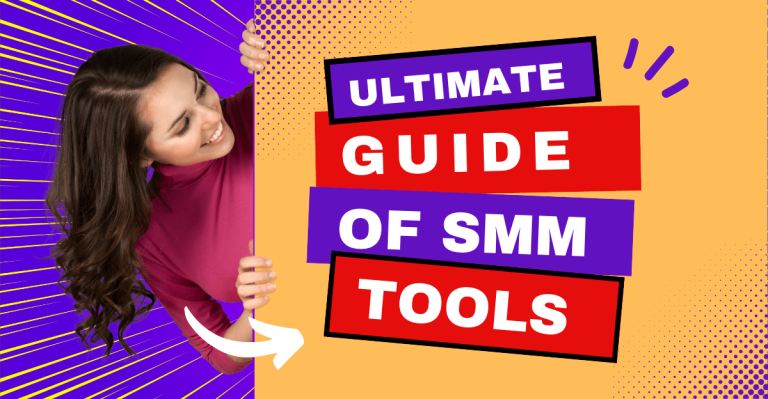Introduction to RFM Analysis
What is the RFM analysis; It is a powerful marketing tool that allows businesses to better understand and categorize their customer base. By assessing how much Recently bought (Recency), the Frequency (Frequency) and the Turnover they have made (Monetary), RFM provides critical information about customer behavior, helping marketers target their communications more effectively. If you're involved in email marketing, RFM analysis can be your secret weapon to create personalised campaigns that not only attract customers but also increase your orders along with loyalty.
In this comprehensive guide, we'll walk you through everything you need to know about RFM analysis - from the basics for beginners to advanced strategies for experienced marketers with relevant examples. By the end of this article, you'll know how to create RFM parts, leverage this information in your email campaigns and ultimately get the most out of your email marketing efforts.
Analysis of what is RFM
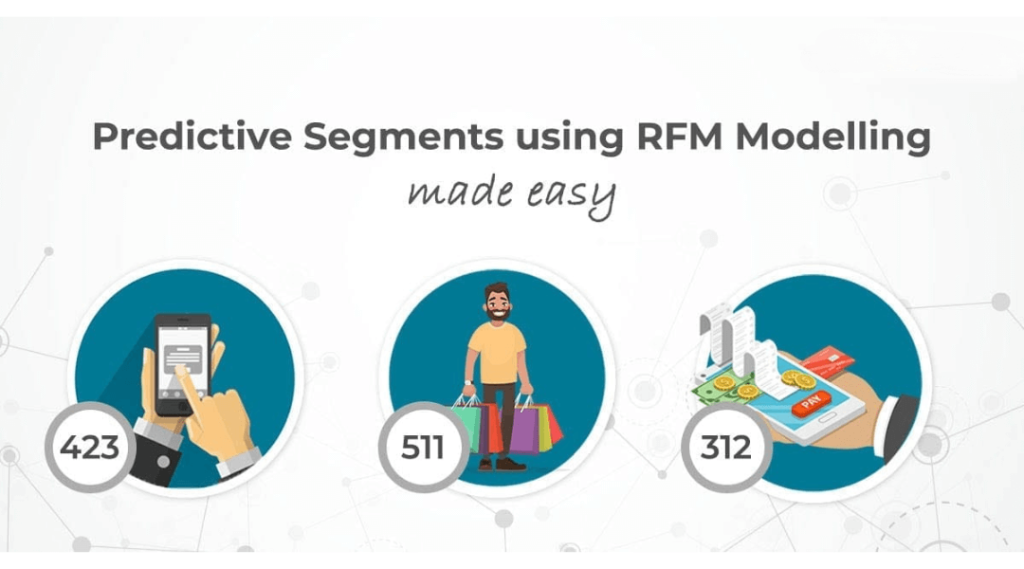
Three main criteria: How recently did they buy (Recency), how often (Frequency) and how much they spend (Monetary). This approach helps businesses identify their most important customers and tailor marketing strategies to increase loyalty and revenue.
How recently (Recency): understanding your customer's timeline
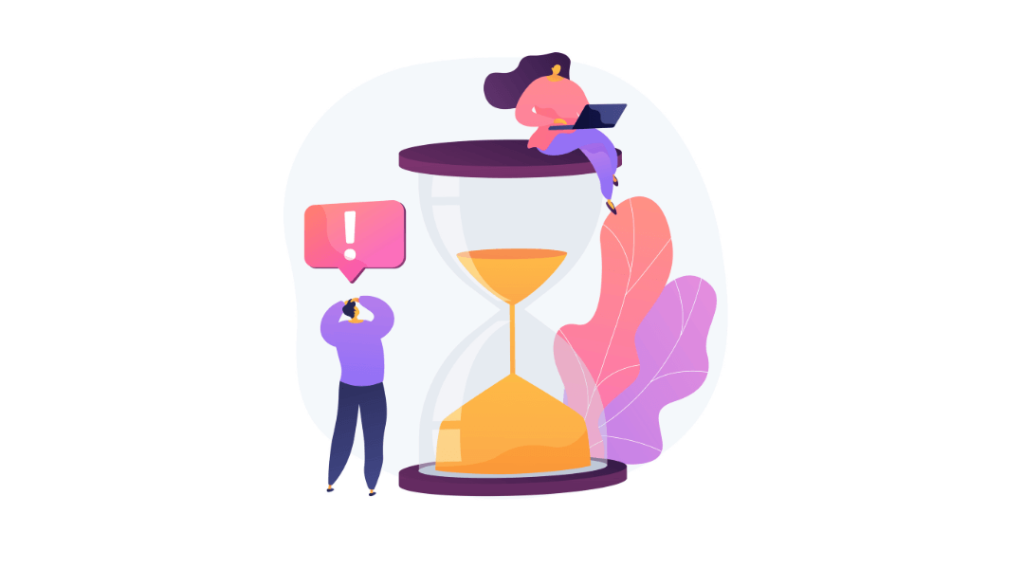
To be clear, Recency refers to how recently a customer made a purchase or interacted with your business. The logic here is simple: customers who have interacted recently are more likely to respond to future campaigns or offers. Knowing your most recently active customers is key to prioritizing your actions in email marketing services.
For example, imagine an e-commerce business that uses the Klaviyo to manage email campaigns. Customers who made a purchase in the last month are classified as "active". You can create a segment for these users, offering personalized content such as exclusive access to products, early access to offers or crossell campaigns. In this way, you leverage recent interaction to maintain momentum and drive repeat purchases.
Tips:
- Always give priority to customers who have interacted most recently.
- Send time-limited offers to recent customers - they are more likely to act immediately.
Frequency: how often customers interact
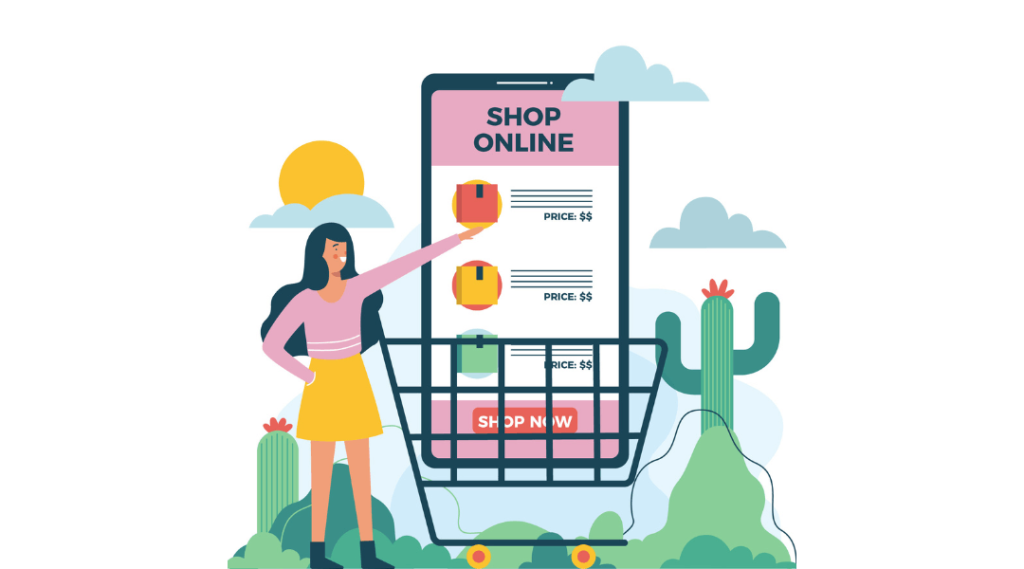
Responding to Frequency measures how often a customer makes purchases or interacts with your content. Customers who buy often are often the VIP of the company, showing a high level of commitment. Recognizing these patterns helps identify your customers who would be interested in rewards or loyalty programs.
At email marketing services, understanding the frequency of interaction helps determine the frequency of messaging. For customers who interact frequently, design loyalty campaigns or exclusive offers that keep them engaged with your brand. For less frequent customers, a subtle reminder or a repeat order prompt email may be more appropriate.
Example: Using Klaviyo, you can automatically set up email flows that are activated based on the frequency of purchases. If a customer makes their third purchase in three months, they can be automatically enrolled in a loyalty program, receiving an email congratulating them on their continued support and offering a reward to encourage future purchases.
Tips:
- Reward frequent buyers to boost loyalty.
- Monitor frequency to adjust the rate of emails sent - don't overload or ignore customers based on their habits.
Monetary Value: amount of customer turnover

Responding to Economic Value focuses on how much a customer has spent in a period. Customers with high financial value are your VIPs - they deserve special treatment to keep them coming back. Offering exclusive benefits, such as early access to promotional periods or personalised offers, can make these customers feel special.
In email marketing, financial value data helps you to identify which customers are worth investing more resources in. Customers with high economic value scores are excellent candidates for exclusive campaigns such as "You are one of the best!" or early access to product launches.
Practical Application: Use the customer separation in Klaviyo to create a "VIP" list. This segment can receive exclusive offers, such as early access discounts or invitations to special events, making them to feel like members of an exclusive club. Personalised recommendations based on previous purchases also work well for these customers.
Tips:
- Always personalize messages for high-value customers to make them feel special.
- Use data from previous purchases to create offers that perfectly match their preferences.
RFM and Email Marketing: the partnership
The RFM analysis is done extremely powerful when combined with email marketing, as it allows you to create highly personalised and targeted campaigns. By dividing your customer base into distinct groups based on their behaviours, you can tailor your messages to meet the specific preferences and needs of each group.
Using RFM to create targeted email campaigns
RFM analysis allows you to categorize your customers into different groups, each of which can be targeted with specific marketing strategies to achieve the best results. Understanding your customers' behavior and targeting them is key to the effectiveness of email campaigns. Here are the key customer groups with appropriate strategies and example actions for each group:
1. champions (333, 332, 323)
Description: The Champions are your best customers. They bought recently and often buy with the highest total historical order value (CLV).
What to do: Incentivize and reward these customers with refferal programs and content they create for you (UGC). Connect closely with this group to grow your business even more.

Champions Strategies (Click To Open)
- Text-based campaigns from the founder or CEO to maintain a personal connection
- Target by SMS if not already registered
- Download a mobile app (if you have a mobile app)
- Send them market surveys, invite them to personal meetings or exclusive events
- Ask for feedback on new products
- Learn from these customers by talking to them
- If you have subscription packages, target them to buy them
- Exclusive information for limited edition product releases
- Excellent candidates for micro-influencer/brand ambassadors
Strategy and examples of actions:
- Log in: Invite them to tell you what they think, as this is valuable for improving your products.
- Loyalty rewards: Send them rewards or coupons for their loyalty, reinforcing their connection to the brand.
- Exclusive access to offers: Be the first to be invited to discounts, promotions or new product launches.
- Collection of reviews: Ask them to write reviews to increase the credibility of the brand.
Example of a campaign: Send an email with the subject "Exclusive invitation to one of our top clients. You!" and offer access to pre-sales before the general public or a special VIP event.
2. Loyal (321, 322, 331, 232, 233)
Description: Loyal are valuable customers who are dedicated and have recently purchased or quite often, but spend less than the Champions.
What to do: Retain these customers and offer incentives to increase their AOV, hoping to move them to Champions.

Loyal Strategies (Click To Open)
- Target by SMS if not already registered
- Download a mobile app (if you have a mobile app)
- Offer 1+1 product or strategic targeting with cross-sell based on what they recently bought
- Ask for feedback on new products
- Learn from these customers by talking to them or sending satisfaction surveys
- Send them a message that they now have access to an exclusive referral program for friends
Strategy and examples of actions:
- Loyalty rewards: Send them rewards or coupons to keep them connected.
- Cross-sells: Suggest products based on their previous purchases.
- Repurchase reminder: Remind them to re-supply products they have purchased in the past with a frequency that is commensurate with the specificity of each product.
- Registration in SMS/MMS: Make sure they are subscribed to SMS marketing for more direct and personalized communication.
Example of a campaign: Send an email "Thank you for your preference!" and offer a 10% discount coupon for their next purchase, with product suggestions that complement their previous purchases.
3rd Recent (312, 313, 311, 222, 223)
Description: Recent customers are those who have bought recently but do not buy often.
What to do: Convert them into repeat customers. Use smart and relevant cross-selling and upselling tactics to get them to buy again.

Recent Strategies (Click To Open)
- Cross-sell campaigns using dynamic product blocks
- Ask them to leave product reviews
- Give them an incentive to make another purchase
- If you have subscription packages, target them to buy them
- Use targeted sign-up forms on your site to promote loyalty or reward programs
- Targeting via SMS and mobile app download
Strategy and examples of actions:
- Conversion to a recurring subscription: Try to convert them into product or service subscribers so they become Champions or Loyal.
- Promotional activities: Send a promotion to encourage a new market.
- Repurchase reminder: Remind them to re-supply products they have purchased in the past with a frequency that is commensurate with the specificity of each product.
- Presentation of reviews: Provide testimonials or reviews from Champions and Loyal to encourage them.
Campaign example: Send an email with the title "Make your next purchase with 15% discount!" and encourage customers to make repeat purchases with the help of reviews from happy customers.
4. needs attention (213, 221, 123, 132, 133)
Description: Customers who in the past have been valuable, but have not purchased recently. At one time, these people were Champions or Loyal, but for some reason they have not made recent purchases.
What to do: Re-attract these customers before they leave. Look to understand why they are not ordering and use this information to bring them back.

Needs Attention Strategies (Click To Open)
- Offer a free trial of a new product or other incentive to attract them back
- Use previous feedback or purchases they have made to highlight NEW, different and better features of your products or services
- Location-based targeting that invites them to come to the physical store to buy
- Targeting via Meta or Google Ads to get their attention again with social proof ads
Strategy and examples of actions:
- Presentation of new products or categories: Let them know about new product releases or new categories/brands.
- Winback Campaign: Try a re-engagement campaign to bring them back.
- Personalized product recommendations: Suggest products based on their previous purchases.
Campaign example: Send an email with the title "We missed you! See what's new for you since last time!" and offer a time-limited coupon to bring them back.
5. at risk (231, 212, 122, 131, 211)
Description: Customers who have not purchased recently and tend to spend less overall. This group likely consists of one-time or few shoppers who didn't spend much.
What to do: Don't spend too much time or energy on these people, as they are very unlikely to reconnect, but give light focus to the winback.

At Risk Strategies (Click To Open)
- Send a targeted winback campaign with an incentive to re-interact
- Send an offer or a coupon limited time
- Make sure you have winback automation to bring them back before they are completely removed
- Targeting via Meta or Google Ads to get their attention again with social proof ads
Strategy and examples of actions:
- Winback Campaign: Try a winback campaign to win them back.
- Low cost promotion: Target more affordable products, as they may be more price sensitive.
- Don't send too many messages: Don't overwhelm them with too many messages, as they are already one step away from being deleted.
Campaign example: Send an email "-20% exclusively for you {'name}." and suggest products with a lower price, offering a coupon to encourage them to return.
6. inactive (111, 112, 113, 121)
Description: Customers who have not purchased for a long time and are inactive.
What to do: Similarly to the previous group, don't spend too much time or energy on these people. The main goal here is to clear the list and keep the the level of deliverability of your account.

Inactive Strategies (Click To Open)
- This group is a collection of low-value customers who have expired and are very unlikely to buy again. While you can try to re-engage this group, it's not a good idea to spend a lot of time or resources trying to re-engage this group. You can also consider excluding this group from your campaigns, as they are not engaged and are unlikely to open or click on your emails.
Strategy and examples of actions:
- Sunset Campaign: Try a sunset campaign with personalised content and an exclusive offer. If they remain inactive, consider removing them from your list to keep your email delivery clean.
- Personalized Offers: Offer exclusive offers to encourage them to buy again.
Campaign example: Send an email entitled "It's time to know the truth. Are you leaving?" If there is no response, consider removing them from your lists to improve the deliverability quality of your emails.
Tips:
- Adjust the frequency and tone of your emails according to behaviour - less frequently for non-active customers, more frequently and exclusively for champions.
- Use dynamic sections in the Klaviyo to ensure that campaigns are always delivered to the right RFM team as customer behaviors change.
Alignment of campaign objectives with RFM groups
The beauty of its use RFM analysis in email marketing is that it helps you align campaign objectives with the needs and preferences of each customer group. Each RFM group represents a different level of relationship with your brand, and therefore your email content should reflect that relationship.
- Ambassadors (High Recency, High Frequency, High Value): Use these sections to strengthen brand support. Consider referral campaigns or incentives for sharing on social media to maximize their influence.
- Inactive (Low Recency, High Frequency, High Value): These customers were valuable in the past, but have become inactive. Use emotional storytelling and powerful incentives to bring them back.
- Young (High Recency, Low Frequency, Low Value): Introduce them to your brand with a series of onboarding emails to introduce them to key products and build trust early on.
Practical Example: Klaviyo's email flows allow you to set up activations based on a customer's RFM score. Imagine a customer with high Recency but low Frequency and Economic Value. You can trigger an email flow that offers a discount on a highly recommended product to encourage a second purchase.
Tips:
- Set clear goals for each RFM group, such as increasing frequency, increasing purchase value or encouraging new behaviors like referrals.
- Create different titles for each segment to maximize open rates, with stronger FOMO for customers you're at risk of losing and a more rewarding approach for loyal customers.
Setting up RFM Analysis in Klaviyo
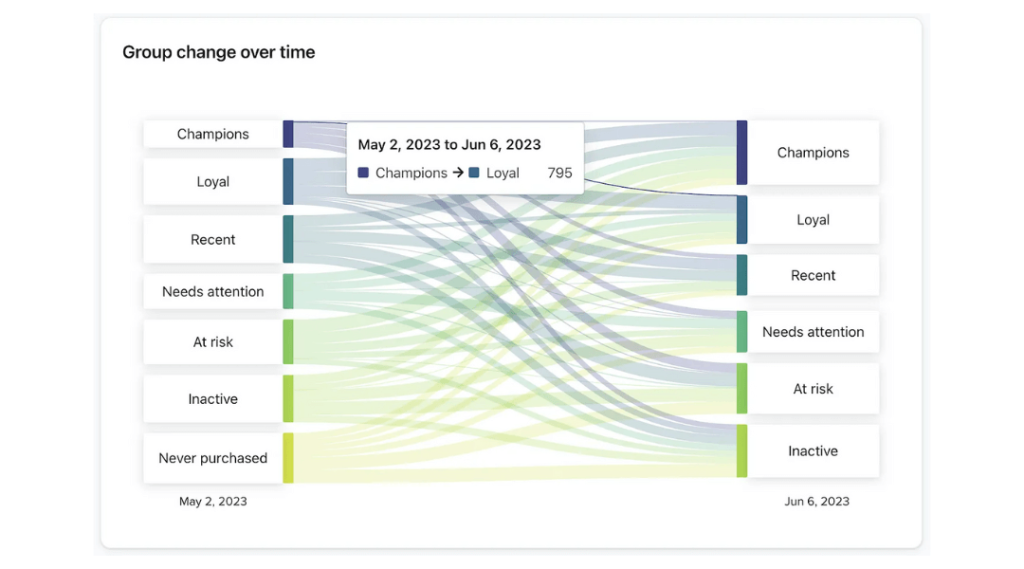
Step by step setup with Klaviyo
If you use Klaviyo, setting up RFM analysis is quite simple if you use the plan that includes the CDP. Otherwise, we have set up custom function taking advantage of the Klaviyo API and webhooks.
Here is a step-by-step CDP guide to integrate RFM analysis into your segregation strategy:
- Data Collection and Introduction
- First, make sure all customer interaction data is flowing to Klaviyo. This includes sales data, customer interactions, and any other related activity.
- Assignment of RFM scales
- Use Klaviyo's segregation tools to assign RFM scores to each client. Customers who have recently purchased may have a score of 5 as far as Recency is concerned, while those who haven't purchased in a long time may have a score of 1.
- Creating Automated Flows
- Based on RFM scores, create flows that automatically send personalized messages to each department. For example, customers with high frequency and financial value can receive invitations to VIP events or special offers.
Tips:
- Plan to refresh your departments on a regular basis to reflect changes in customer behaviour.
- Use dynamic content to customize messages according to the RFM segment to which each customer belongs.
Case Studies and Practical Examples
Putting RFM analysis into practice helps businesses to understand their customer base more deeply and create campaigns that are more relevant and effective. Let's look at some real-world examples of how businesses are using RFM analysis to improve the performance of their email marketing campaigns.
Real Applications of RFM in Email Marketing
- Convert customers to VIP members
- A cosmetics company used RFM to identify customers who buy frequently but do not spend large amounts. Through a special upgrade campaign, VIP benefits such as free product samples or access to limited discounts were offered. This approach increased the value of these customers' purchases, with most increasing their spend by 20%.
- Retrieve customers who have been removed
- A clothing retailer used Klaviyo to identify customers with low prevalence and low frequency. These customers were classified as "at-risk customers". To recover them, he created a reactivation campaign with the theme "We miss you" and offered a 15% discount for the next purchase. This campaign resulted in 30% reactivation of these customers.
- Exploitation of repeat buyer points
- A nutritional supplement seller created campaigns targeting customers with a high purchase frequency. These customers received personalized recommendations for new products based on their previous purchases. This personalized approach led to a 25% increase in conversion rate as customers saw exactly the products they were most interested in.
Tips for Practical Application:
- Use the data from the RFM analysis to identify the best offers for each segment. Customers who buy often and spend a lot will respond better to exclusive offers and events.
- Create email campaigns that recognize and reward loyalty. A simple recognition can make customers feel special and boost their loyalty.
Advanced strategies for experienced marketers
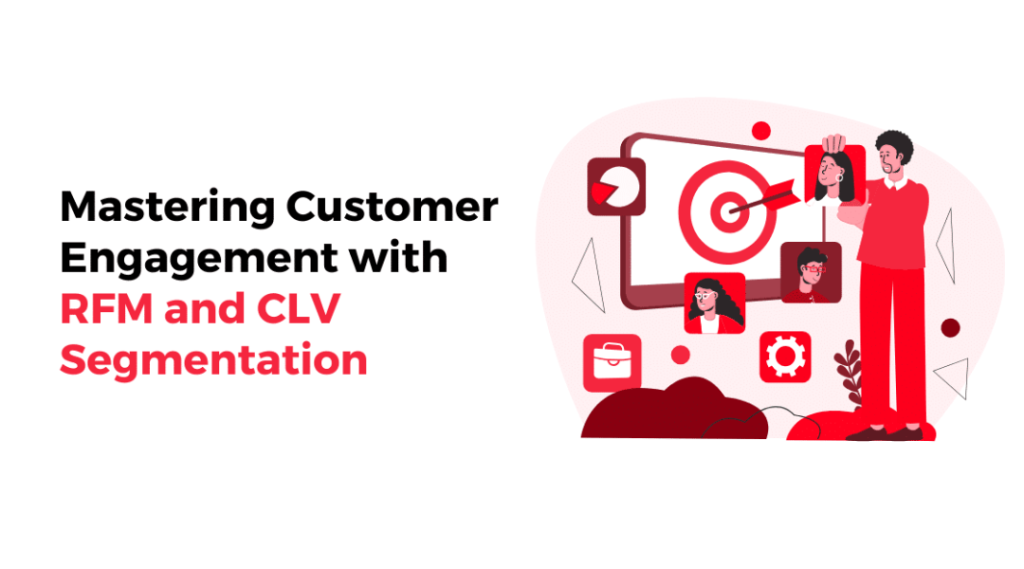
Once you understand the basic function of RFM analysis, there are several advanced techniques you can use to take your analysis to the next level. Let's take a look at some of these strategies.
Combining RFM with other measurements for deeper targeting
RFM is a great tool for understanding customer behaviour, but when combined with other metrics such as the Customer Lifetime Value (CLV), the effects are even more powerful. For example, customers with high RFM scores but low CLV may be candidates to receive actions that will airlift them into the next RFM segment to increase their overall value.
Application Example: You can create a customer segment that has high Recency and frequency but low CLV. Send these customers offers for premium products with higher value to increase their average order.
Predictive modelling based on RFM data
Predictive modeling is a technique that can be used to predict future customer behaviors based on past behaviors. Using RFM scores combined with AI learning, you can predict which customers are more likely to become champions or inactive. This information can be used to create proactive campaigns that reduce the likelihood of customer churn and increase loyalty.
Practical Example: Use Klaviyo's data tools to analyse which customers are most at risk of stopping their purchases. Create automation that triggers before these customers become inactive, giving them a powerful incentive to stay loyal.
Personalisation techniques to optimise the performance of campaigns
Personalization is critical to the success of email campaigns. By using RFM data, you can personalize not only the content of emails, but also the timing, frequency, and how you communicate. For example, customers with high recency and frequency may receive emails more frequently, while at-risk customers may receive fewer, but more targeted and enticing messages.
Tips:
- Use personalized themes and offers based on customer behavior. RFM analysis can show you which customers will respond to discounts and which will respond best to exclusive offers.
- Experiment with different shipping times for each segment. Customers who buy frequently may prefer morning deals, while customers who are inactive may respond better in the afternoon or on the weekend.
Challenges and factors to consider
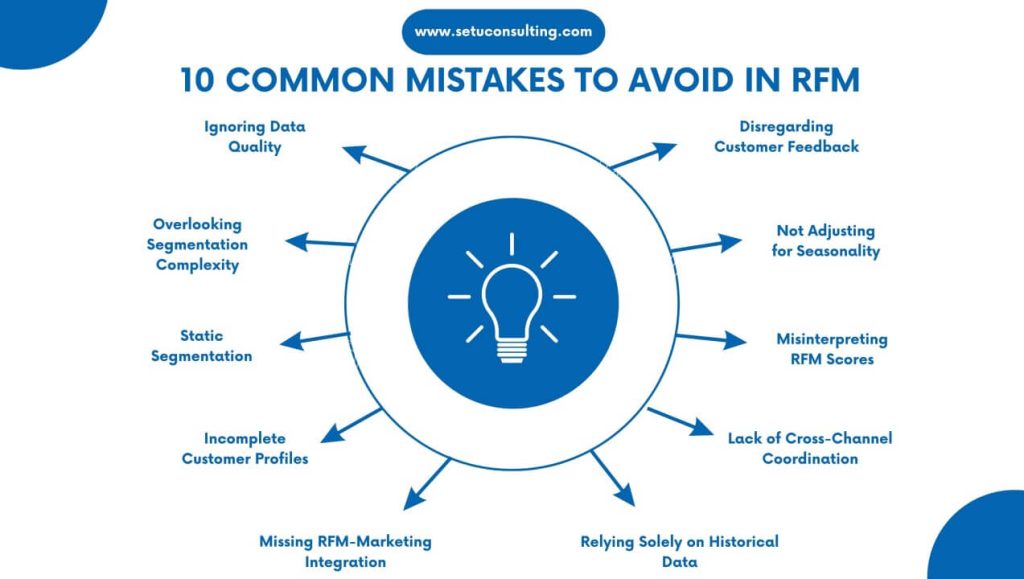
Although RFM analysis is an extremely useful tool, there are some challenges to consider when implementing it.
Common Mistakes in RFM Analysis
- Data quality oversight:
🚫 False: neglect of accurate data collection.
✅ Solution: regularly check and clean customer data to ensure accuracy.
- Overlooking the complexity of segmentation:
🚫 Wrong: Creating overly complex parts.
✅ Solution: keep segments manageable by focusing on key RFM factors for clarity.
- Static Segmentation
🚫 Error: not informing customer departments.
✅ Solution:Regularly reassess and adjust departments based on changing customer behaviour.
- Incomplete Customer Profiles
🚫 Error: lack of comprehensive customer data.
✅ Solution: collect additional information to improve the accuracy of the profile and analysis.
- Failure to integrate RFM with Marketing
🚫 False: keeping RFM separate from marketing strategies.
✅ Solution: integrate RFM insights into marketing campaigns for targeted effectiveness.
- Disregarding customer feedback
🚫 Wrong: Ignoring the opinions and preferences of customers.
✅ Solution: integrate feedback into RFM strategies for a holistic approach.
- Non-adaptation for seasonality
🚫 Wrong: Failure to take seasonal trends into account.
✅ Solution: adapt RFM strategies based on seasonal variations in customer behavior.
- Misinterpretation of RFM Ratings
🚫 Incorrect: Incorrect interpretation of customer ratings.
✅ Solution: ensure a clear understanding of RFM measurements and their implications.
- Lack of Interchannel Coordination
🚫 Wrong: Performing unrelated marketing efforts.
✅ Solution: coordinate efforts across all channels to deliver a seamless customer experience.
- Based solely on historical data
🚫 False: current customer behaviour is not taken into account.
✅ Solution: combine historical data with real-time information for a comprehensive view.
Tips to overcome these challenges:
- Invest in a tool like Klaviyo to automate the separation and updating of your customer departments.
- Ensure that the data you use for RFM is always up to date and check regularly for accuracy.
Future trends in RFM and Email Marketing
The world of email marketing is constantly evolving, and so is RFM analytics. The use of artificial intelligence and machine learning will change the way marketers segment and target their customers.
- Predictive analysis with artificial intelligence
- AI can enhance the effectiveness of RFM analytics, allowing marketers to predict future buying trends and adjust their campaigns accordingly.
- Even more personalised campaigns
- In the future, email campaigns will become increasingly personalized using RFM data. Customers will receive messages that appear to be designed just for them, increasing engagement rates and conversions.
RFM analysis is an extremely powerful tool that can help you understand and interact with your customers more effectively. Used correctly, you can increase loyalty, improve conversions and build a loyal customer base. Remember to continually adjust your strategies based on RFM results and invest in technology that helps you get the most out of your data.
Sources:
- The Research Behind Our New RFM Feature
- Understanding scoring and customer groups in the recency, frequency, and monetary analysis (RFM) report
- Build impactful retention strategies using RFM analysis
- How to build a segment using RFM properties
- Getting started with the recency, frequency, and monetary (RFM) analysis report
- How to strategically use RFM properties in campaigns and flows


